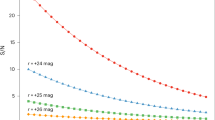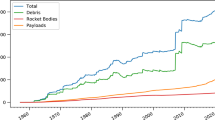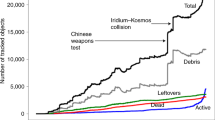Abstract
Near-Earth space is becoming increasingly privatized, with the number of satellites in low-Earth orbits predicted to grow dramatically from about 2,000 at present to over 100,000 in the next decade due to the launch of planned satellite constellations. In addition to their direct impact on astronomy, the manner and pace of ‘occupying’ near-Earth space raises the risk of repeating the mistakes of colonization on a cosmic scale. We must consider the impact of satellite constellations, and related future initiatives, on the essential human right to dark skies and on cultural sky traditions across all peoples. We must also include all stakeholders for near-Earth space in the process of developing new policies for space treaties and planetary protection, the consequences of which will reach far beyond this century. We advocate for a radical shift in the policy framework of international regulatory bodies towards the view of space as an ancestral global commons that contains the heritage and future of humanity’s scientific and cultural practices.
This is a preview of subscription content, access via your institution
Access options
Access Nature and 54 other Nature Portfolio journals
Get Nature+, our best-value online-access subscription
$32.99 / 30 days
cancel any time
Subscribe to this journal
Receive 12 digital issues and online access to articles
$119.00 per year
only $9.92 per issue
Buy this article
- Purchase on SpringerLink
- Instant access to full article PDF
Prices may be subject to local taxes which are calculated during checkout

Egon Filter.
Similar content being viewed by others
References
Serjeant, S., Elvis, M. & Tinetti, G. The future of astronomy with small satellites. Nat. Astron. https://doi.org/10.1038/s41550-020-1201-5 (2020).
Milazzo, M. P, Richey, C., Piatek, J., Vaughan, A. & Venkatesan, A. The Growing Digital Divide and its Negative Impacts on NASA’s Future Workforce (2020); https://go.nature.com/2S5zaIb
Walker, C. et al. Impact of Satellite Constellations on Optical Astronomy and Recommendations Toward Mitigations (NOIRLab, 2020); https://go.nature.com/30fAFbe
Hainaut, O. R. & Williams, A. P. Impact of satellite constellations on astronomical observations with ESO telescopes in the visible and infrared domains. Astron. Astrophys. 636, A121 (2020).
McDowell, J. C. The low Earth orbit satellite population and impacts of the SpaceX Starlink constellation. Astrophys. J. Lett. 892, L36 (2020).
Massey, R., Lucatello, S. & Benvenuti, P. The challenge of satellite megaconstellations. Nat. Astron. https://doi.org/10.1038/s41550-020-01224-9 (2020).
Levchenko, I., Xu, S., Wu, Y.-L. & Bazaka, K. Hopes and concerns for astronomy of satellite constellations. Nat. Astron. https://doi.org/10.1038/s41550-020-1141-0 (2020).
Hall, J. et al. Light pollution, radio interference, and space debris: threats and opportunities in the 2020s. Bull. Am. Astron. Soc. 51, 97 (2019).
Shahar, K. & Greenbaum, D. Lessons in space regulations from the lunar tardigrades of the Beresheet hard landing. Nat. Astron. 4, 208–209 (2020).
Rivkin, A. S. et al. Asteroid Resource Utilization: Ethical Concerns and Progress (2020); https://go.nature.com/2SjvD9z
Kimmerer, R. W. Braiding Sweetgrass: Indigenous Wisdom, Scientific Knowledge and the Teachings of Plants (Milkweed Editions, 2015).
Vidaurri, M. et al. Absolute prioritization of planetary protection, safety, and avoiding imperialism in all future science missions: a policy perspective. Bull. Am. Astron. Soc. 51, https://baas.aas.org/pub/2020n7i276 (2019).
Venkatesan, A. et al. Towards inclusive practices with indigenous knowledge. Nat. Astron. 3, 1035–1037 (2019).
Tavares, F. et al. Ethical Exploration and the Role of Planetary Protection in Disrupting Colonial Practices (2020); https://go.nature.com/337LEFG
Prem, P., Hurley, D. M., Goldstein, D. B. & Varghese, P. L. The evolution of a spacecraft-generated lunar exosphere. J. Geophys. Res. Planets 125, e06464 (2020).
Lorenz, R. D. Lander rocket exhaust effects on Europa regolith nitrogen assays. Planet. Space Sci. 127, 91–94 (2016).
Tepper, E. & Whitehead, C. Moon, Inc.: the New Zealand model of granting legal personality to natural resources applied to space. New Space 6, 288–298 (2018).
Vidaurri, M. & Gilbert, A. Environmental Considerations in the age of Space Exploration: The Conservation and Protection of Non-Earth Environments (2020); https://go.nature.com/343ioPK
Penprase, B. E. The Power of Stars 2nd edn (Springer, 2017).
Maryboy, N. et al. The Cosmic Serpent: Collaboration with Integrity. Bridging Native Ways of Knowing and Western Science in Museums Settings (Indigenous Education Institute, 2012).
Cajete, G. Native Science: Natural Laws of Interdependence (Clear Light Publishers, 2000).
Lee, A. S., Rock, J., Wilson, W. & Gawboy, C. The Red Day Star, the Women’s Star and Venus: D(L/N)akota, Ojibwe and other indigenous star knowledge. Preprint at https://arxiv.org/abs/2009.02127 (2020).
Venkatesan, A. & Burgasser, A. Perspectives on the Indigenous worldviews in informal science education conference. Phys. Teach. 55, 456 (2017).
Venkatesan, A. et al. Collaboration with integrity: Indigenous knowledge in 21st century astronomy. Bull. Am. Astron. Soc. 51, https://baas.aas.org/pub/2020n7i020/release/1 (2019).
Lee, A. S., Brummel, S., Ehret, K., Komperud, S. & LaCoursiere, T. Building a framework for indigenous astronomy collaboration: native skywatchers, indigenous scientific knowledge systems, and the Bell Museum. Preprint at https://arxiv.org/abs/2008.07270 (2020).
Smith, L. T. Decolonizing Methodologies: Research and Indigenous Peoples (Zed, 2012).
Maryboy, N., Begay, D. H. & Nichol, L. Paradox and transformation. Int. J. Appl. Sci. Sustain. Dev. 2, 15–24 (2020).
Acknowledgements
We dedicate this piece to the shared wealth of space as an ancestral global commons for humanity’s scientific and cultural achievements and legacy. We express our profound gratitude to K. Krafton (AAS Bahcall Public Policy Fellow) whose invaluable expertise and around-the-clock availability for our questions were critical for this work. A.V. gratefully acknowledges her deeply sustaining work-life ecosystem, including her ancestors and her team of collaborators who model transformative partnerships between Indigenous and non-Indigenous knowledge systems: I. Hawkins, N. Maryboy, D. Begay, K. Kimura, L. Peticolas, A. Burgasser, D. Simons, A. Lee, L. Kimura, C. Baybayan, R. Wolfgramm, T. Wolfgramm, W. Kingi, C. Spiller, W. Barreno and J. Mucia. They have patiently taught and trusted her with their knowledge-keeping—their wisdom and stories are her medicine.
The views, thoughts, and opinions expressed in this article are those of the authors, and do not necessarily reflect the official policy or position of the authors’ employers, or any other organization, agency, committee or other group or individual.
Author information
Authors and Affiliations
Corresponding author
Ethics declarations
Competing interests
The authors declare no competing financial interests.
Additional information
Publisher’s note Springer Nature remains neutral with regard to jurisdictional claims in published maps and institutional affiliations.
Supplementary information
Supplementary Video
A timelapse video of the dawn skies over the Gemini Observatory on the summit of Maunakea, Hawai‘i in November 2019, showing passing Starlink satellites. Credit: INTERNATIONAL GEMINI OBSERVATORY/NOIRLAB/NSF/AURA.
Rights and permissions
About this article
Cite this article
Venkatesan, A., Lowenthal, J., Prem, P. et al. The impact of satellite constellations on space as an ancestral global commons. Nat Astron 4, 1043–1048 (2020). https://doi.org/10.1038/s41550-020-01238-3
Received:
Accepted:
Published:
Issue date:
DOI: https://doi.org/10.1038/s41550-020-01238-3
This article is cited by
-
A call for Indigenous partnership in the return to the Moon
Nature Astronomy (2024)
-
Opportunity to view the starry night sky is linked to human emotion and behavioral interest in astronomy
Scientific Reports (2024)
-
Aggregate effects of proliferating low-Earth-orbit objects and implications for astronomical data lost in the noise
Nature Astronomy (2023)
-
Dark Skies and Bright Satellites
Resonance (2023)
-
Semi-Empirical Astronomical Light Pollution Evaluation of Satellite Constellations
The Journal of the Astronautical Sciences (2023)



